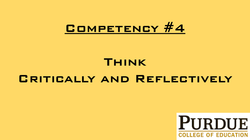
- Develops a personal vision of inclusive educational practice.
- Describes the relationship between Educational Technology and the broader field of Education.
- Critically evaluates theory and practice.
Return to RB Purdue LDT Portfolio Homepage
Artifacts: EDCI 672 Beth Owens Case Study Fall 2016
Narrative:
I have selected an artifact from my Fall 2016 course focused on case study analysis. This course provided great insight as to how the instructional designer role can, and often does, expand well beyond the bounds of their 'defined' task. This particular analysis involved an instructional designer being contracted by a small college to enhance a growing culinary course with several conflicting challenges.
This case analysis was early in the course and required us to 'read' several participants and consider options for redesigning (optimal mix of theory and practice) the multi-course culinary arts program. Balancing apparent success of output with an interest in better addressing first year student needs while working with the strong-willed upper level instructor made for some heated course design debate. This relationship was framed nicely as "entry-level classes need to be more demographically tolerant while systematically introducing the personal adjustments that each student will need to make in order to be a success in the program."
Significant cohort time was spent debating the relationship between upper level courses that place their students in jobs effectively and better first year course experiences that may lead to the same, or greater, success. We saw the practice, but needed to confirm/define the theory behind it. I summed up the instructional designer situation succinctly in the analysis phase with "Beth needs to investigate...how to keep quality constant or increasing while attracting and retaining greater quantities of students in the program. Her biggest challenge is to build and implement the changes with the blessing of Chef Reiner. A tall order." Beth's focus was to be on the instructional design, or human performance aspects, while Chef Reiner kept his eye on the actual educational content and post-college viability thereby providing a textbook view of the relationship between Education Technology and the broader field of Education.
We were also forced to consider personal bias and how that impacts our view of what practices are most effective for a particular situation in a classroom. Shedding this bias will help us be more inclusive of competing and, potentially, superior designs to deploy. Chef Reiner was the upper level instructor and my suggestion (following) for addressing his role holds the keys for success.
Changing the "delivery system of the entry level courses...will be the most challenging aspect of the project as Beth is tasked with changing Chef Reiner's 'baby', and Chef Reiner will undoubtedly be difficult to work with in this area. Beth can expect a plethora of negatives for each and every change that she proposes. Beth may need to 'grease the wheels' by asking Chef Reiner to prepare his favorite meal for herself, Dean Jacobs, and Chef Reiner one evening while they talk through scenarios. Their 'kitchen talk' will be critical to success."
The conundrum of building a welcoming program that prepares students for a very harsh culinary industry requires significant vision, relationship analysis, and a critical evaluation of theory and practice. "Though Beth's training suggests that moving to a fully student-centered design is the best move educationally, because this program places students directly into a highly competitive workforce, Chef Reiner's simulation of workspace demands is actually critical preparation for the students. Therefore, the mix of instructional designs best fits the needs of State College's students."
As this case study occurred very early in the class, it served well to open our eyes to the wide array of potential impacts that need to be considered when an instructional designer is assessing a situation. The key takeaway is to understand than an ID must look outside the 'task at hand' to develop a personal vision of inclusive educational practice while ensuring that all environmental impacts are considered.
